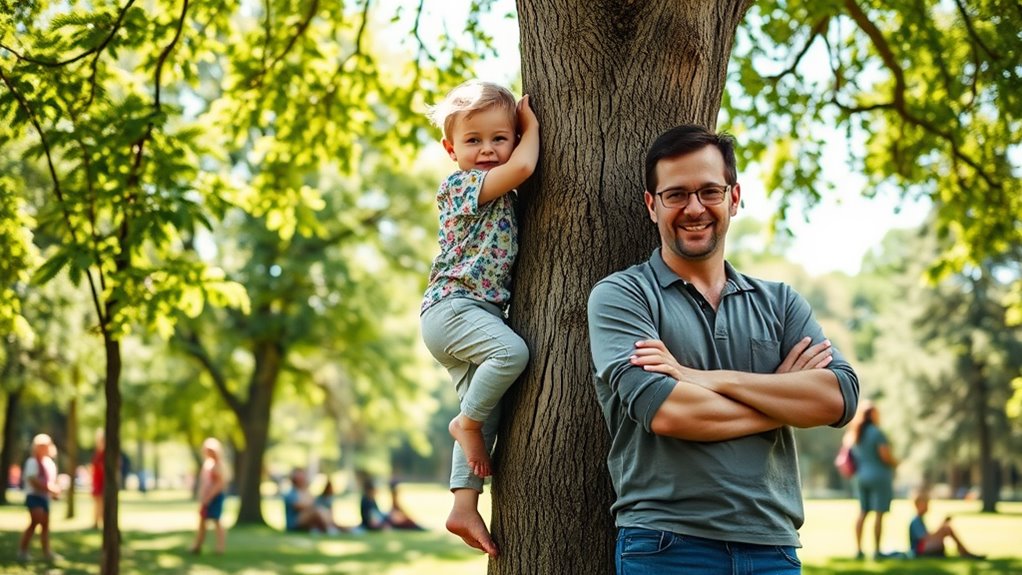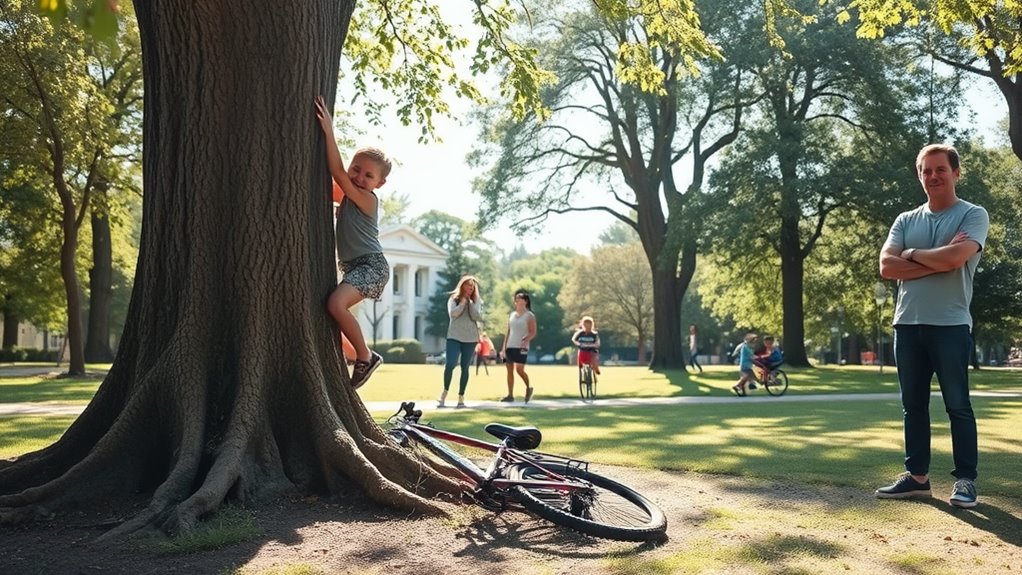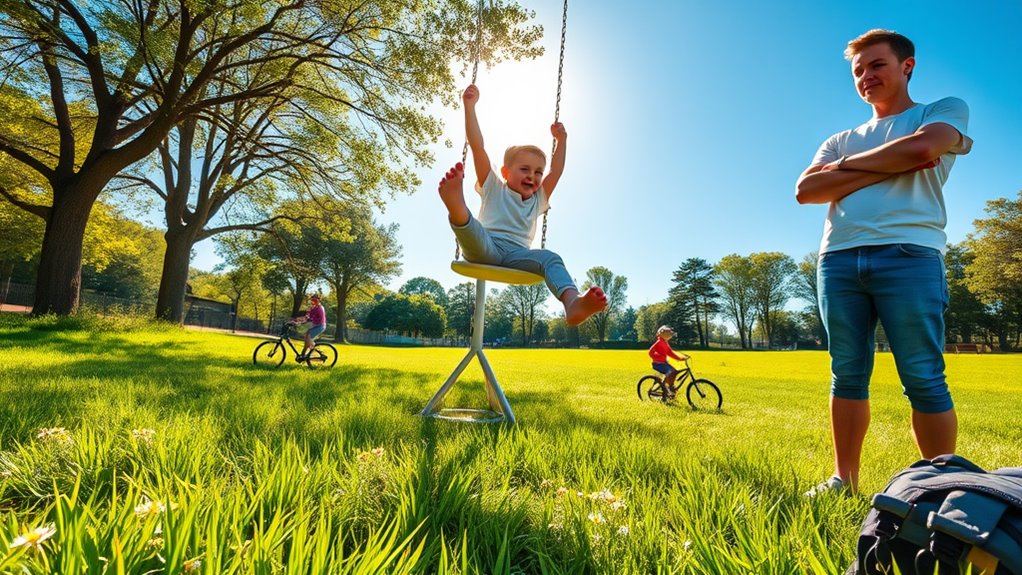Balancing Safety and Freedom in Free-Range Parenting
Balancing safety and freedom in free-range parenting means giving your child chances to explore while keeping them safe from risks. You can encourage independence by gradually letting them take on responsibilities and make choices. It’s crucial to set clear safety guidelines and identify safe zones for play. Supervised outdoor activities can build confidence and help your child develop problem-solving skills. Open communication is key; listen to their feelings and share your own experiences to strengthen your bond. By carefully evaluating risks and rewards, you’ll create a supportive environment. Stay tuned, as there’s more to discover about fostering this balance!
Understanding Free-Range Parenting

Free-range parenting is like letting your child roam in a wide-open field, where they can explore and learn independently. This approach encourages kids to take charge of their own experiences, helping them develop confidence, problem-solving skills, and resilience. You give your child the freedom to play outside, make choices, and even face challenges, all while knowing you’re nearby to support them when needed.
Understanding free-range parenting means recognizing that it’s not about being careless or neglectful. Instead, it’s about trusting your child to navigate their world. You might let them walk to a friend’s house without supervision or allow them to climb a tree. These moments teach essential life lessons, like evaluating their capabilities and understanding consequences.
While embracing this parenting style, it’s important to maintain open communication with your child. Encourage them to share their experiences and feelings, fostering a strong bond.
This way, you create a safe environment where your child feels comfortable exploring. Ultimately, free-range parenting is about balancing independence with guidance, allowing your child to thrive as they discover their unique place in the world.
Assessing Risks and Benefits

When embracing free-range parenting, evaluating the risks and benefits becomes essential. You’ve got to weigh how much freedom you want your child to have against the potential dangers they might face.
Allowing your child to explore the world independently can build confidence and resilience, which are fundamental life skills. However, it’s important to recognize that some situations may pose genuine risks that could lead to harm.
Think about the specific activities your child wants to engage in. For example, letting them ride their bike around the neighborhood can encourage independence and responsibility, but you should also consider traffic and road safety.
Similarly, allowing your child to play outside without constant supervision can foster creativity and social skills, yet it’s important to assess the environment for potential hazards.
Strategies for Encouraging Independence

One effective strategy for encouraging independence in your child is to gradually increase their responsibilities. Start with small tasks that you know they can handle, like making their bed or packing their lunch. As they become more comfortable, you can add more challenging responsibilities, such as managing their homework schedule or helping with grocery shopping. This gradual approach helps build their confidence and skills.
Another way to foster independence is to allow your child to make choices. Encourage them to select their clothes or decide what to do on weekends. This not only gives them a sense of control but also helps them learn how to weigh options and make decisions.
Additionally, encourage problem-solving. When your child faces a challenge, resist the urge to solve it for them. Instead, ask guiding questions that prompt them to think critically about the situation. This process teaches them to rely on their own judgment and resourcefulness.
Lastly, celebrate their successes, no matter how small. Positive reinforcement boosts their confidence and motivates them to take on new challenges.
With time and patience, you’ll witness your child blossom into a more independent and self-sufficient individual.
Setting Safety Boundaries

Setting clear safety boundaries is essential for fostering a sense of security while allowing your child to explore their independence. You want your child to feel empowered, but it’s equally important to establish limits that keep them safe.
Start by identifying the areas where your child can roam freely, like the backyard or nearby park, and then set guidelines for those spaces.
Explain what’s acceptable behavior, such as not talking to strangers or wandering too far. You might also consider creating a “safe zone,” a specific distance they can explore without losing sight of you. This way, they can venture out but still remain within a safe range.
Also, think about potential risks in your environment—busy streets, bodies of water, or even playground equipment—and guarantee your child understands these dangers.
Use simple, clear language to convey your expectations.
Communicating With Your Child

Establishing safety boundaries isn’t just about rules; it’s also about fostering open communication with your child. When you encourage your child to express their thoughts and feelings, you create a safe space for them to share concerns. This can help you both understand each other better and build trust.
Start by asking open-ended questions. Instead of, “Did you have a good day?” try, “What was the best part of your day?” This invites them to share more than just a one-word response. Actively listen to their answers, showing genuine interest. Acknowledge their feelings, even if you don’t always agree. This validation helps them feel heard and valued.
Also, share your own experiences. When you talk about your childhood, your child can relate better to your perspective. It makes conversations feel less like lectures and more like a two-way street.
Lastly, remind your child that it’s okay to come to you with tough topics. Emphasize that your conversations are a judgment-free zone. When they realize they can talk to you openly, they’ll feel more comfortable discussing safety and freedom, leading to a healthier, more balanced relationship.
